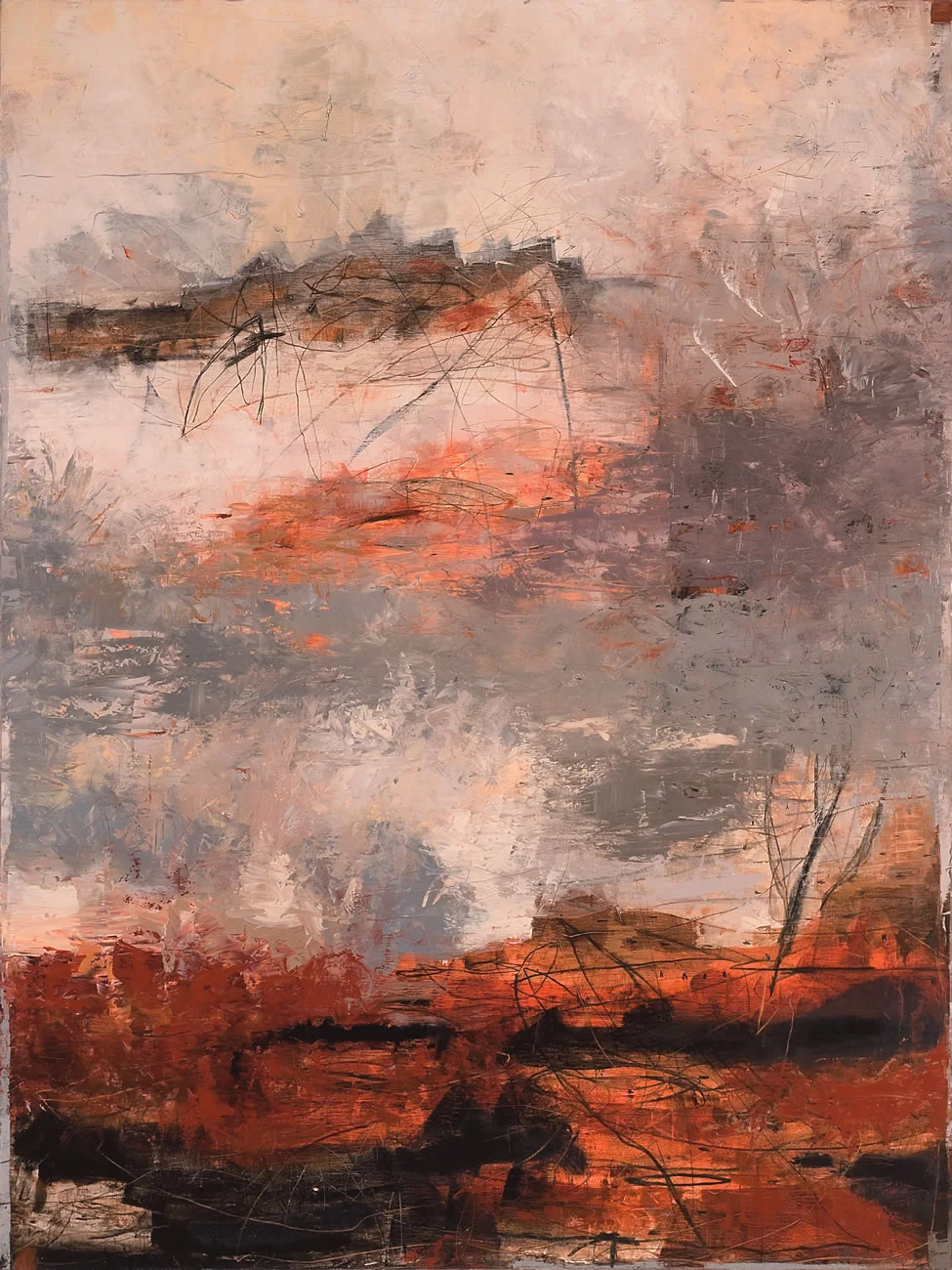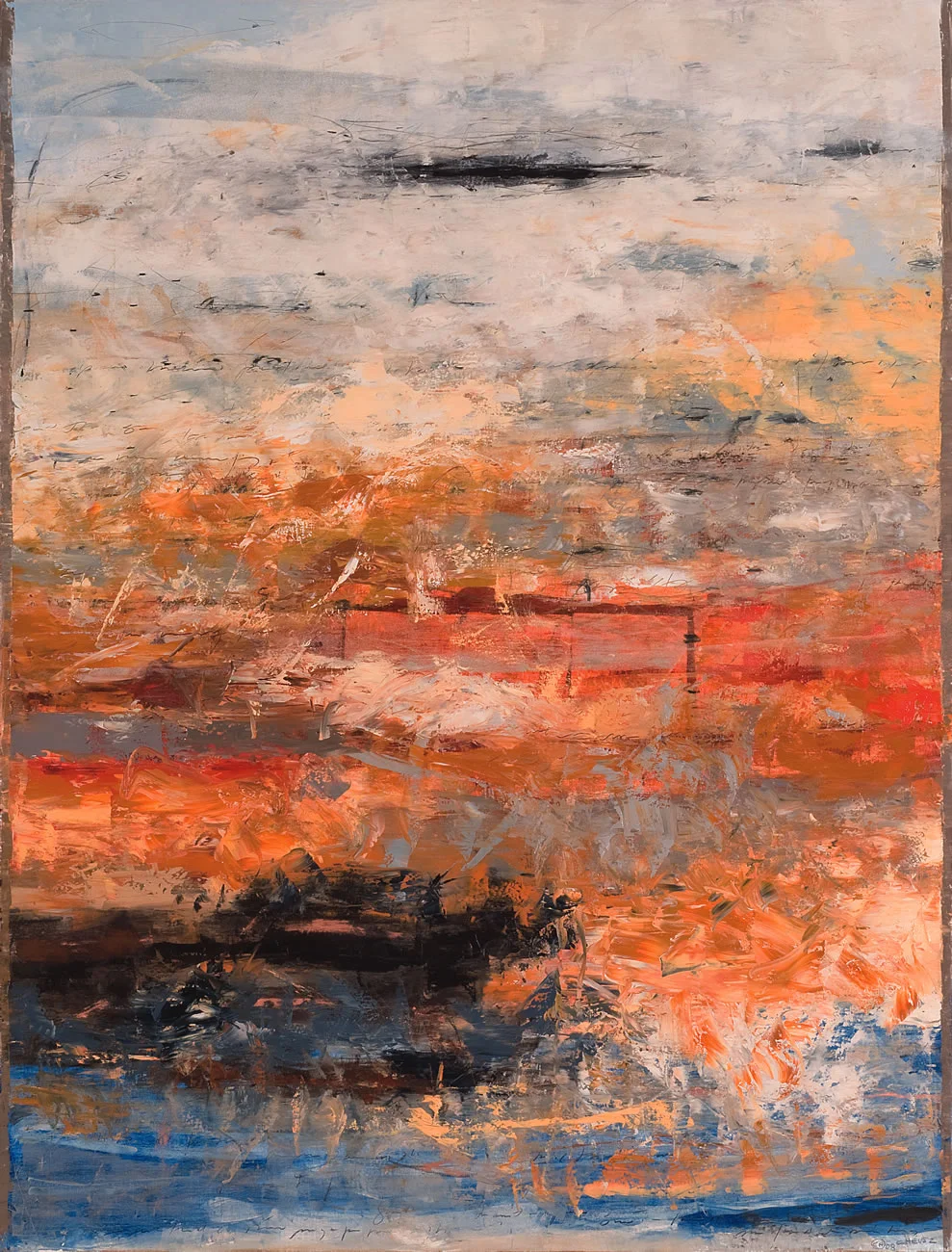Por Daniela Castillejos Chévez
para Inscripción de lo Sagrado, 2009
Inscripción de lo sagrado. Un título directo, que en su sencillez carga con un contenido profundo y complejo. Podría parecer presuntuoso nombrar así una exposición, declararse así escritor (o en este caso, pintora) de lo sagrado. Si no se tratase de esta artista, pondría en duda la autenticidad del título. Sin embargo, la obra es testigo de la entrega de Virginia en la práctica de la pintura, del ser y hacerse artista; así, quienes contemplamos esta obra nos hacemos también testigos de dicha entrega. Cada trazo, cada gesto, cada pieza que conforma esta exposición declaran esta verdad. Si la práctica hace al maestro, Virginia Chévez es, por mucho, una maestra de la pintura. Su obra y su trabajo se manifiestan como un ofrecimiento al universo, y es en esa ofrenda en que la obra se sacraliza. Aquella presunción que podríamos imaginar por el título de la exposición queda anulada frente a la aceptación de Virginia Chévez de reconocerse como un medio a través del cual el universo se expresa en una forma perceptible al ser humano, a cada uno de los espectadores de este trabajo.
Esta exposición es una invitación para reconocer en la vida diaria que todo lo que hacemos, así como todo lo que nos rodea, es fundamentalmente sagrado. Si bien los templos y escritos sagrados buscan poner en manifiesto aquello que es sacro, el poder de santificar la vida reside en cada uno de nosotros, en nuestro diario acontecer, en nuestro diario vivir. Lo sagrado, entonces, puede estar presente en una galería de arte, en una oficina, en una casa, en una familia, en la relación con uno mismo; en cada rincón y fragmento de vida. Al presentarnos una exposición cuyo contenido es la inscripción de lo sagrado, Virginia Chévez busca un reconocimiento por parte de cada uno de nosotros para aceptarnos igualmente como medios a través del cual el universo se expresa. Es, en realidad, una llamada a confesarnos también escritores de lo sagrado.
Observar la obra de Virginia Chévez es trascender las fronteras del óleo y del lienzo para sumergirse en un mundo de total paz, de absoluto silencio, donde el alma se descubre a sí misma gozando el paisaje interior. Colores que se entrelazan en completa armonía con el sonido del universo, matices que nos envuelven en un eterno abrazo para transportarnos al hogar fundamental del ser. Contemplación en soledad que acoge y abriga; meditación hecha pintura que invita a olvidarse en la existencia y entregarse ante la inmensidad del universo.
Resulta un alivio contar con una artista contemporánea que a través de un estilo poco convencional o fácil como lo es el expresionismo abstracto proponga un redescubrimiento y encuentro con lo divino, no como algo inalcanzable, increíble o fuera de lo ordinario, muy al contrario, como algo innato, perenne y esencial en cada ser humano, presente en la vida interior y reflejado en el mundo que nos rodea. No es sólo un alivio, desde mi punto de vista y experiencia personal, es también una fuente de inspiración, desde la obra y desde la artista. Pues aquello que nos hace escritores de lo divino no surge por una simple coincidencia sin sentido. Surge de una auténtica entrega, evidente tanto en la obra como en la persona de Virginia Chévez. Inscripción de lo sagrado que inspira, que abre alma y corazón para aceptar el aliento universal; para descubrir aquello que nos hace seres divinos más allá de seres humanos; para percibir lo fundamentalmente sagrado en cada instante; para inhalar arte y recibir vida.
Scribes Of The Sacred
By Daniela Castillejos Chévez
for Inscripción de lo Sagrado, 2009
Inscripción de lo sagrado (Inscription of the Sacred). A direct title that in its simplicity conceals a deep and complex sense. It might seem conceited to give that name to an exhibition; to declare oneself a scribe (or in this case, painter) of the sacred. If it weren’t this artist, I would question the genuineness of such title. And yet, these paintings witness Virginia’s commitment to the practice of painting, to being and becoming an artist. Thus, we as spectators also become witnesses to this commitment. Each stroke, each gesture, each piece included in this exhibition are statements of this truth. If practice makes perfect, Virginia Chévez has perfected the mastery of painting. Her work embodies an offering to the universe, and that is precisely what makes it sacred. Any pride we might have attached to the title is cancelled out by the artist’s acceptance of being a means through which the universe manifests itself in ways that are perceptible to the human subject, to each of us viewers of this oeuvre.
The exhibition is also an invitation to acknowledge the sacredness in everything we do and all that surrounds us in everyday life. Temples and scriptures seek to reveal to us that which is sacred, but the power of sanctifying life resides inside each one of us, in our daily comings and goings. It is thus that the sacred can find shelter inside an art gallery, an office, a house, a family; in any person’s relationship to themselves, in every corner and fragment of existence. By presenting us with a series of paintings whose content is the inscription of the sacred, Virginia Chévez seeks for every one of us to accept that we are also a means through which the universe finds expression. It is really an invitation to declare ourselves to be scribes of the sacred as well.
The very act of viewing the works of Virginia Chévez implies transcending the boundaries of oil and canvas to access a world of total peace and utter silence where the soul finds itself enjoying its inner landscape. Colors entwine themselves in complete harmony with the sound of the universe; their hues embrace us and carry us to the self’s fundamental abode –an act of solitary contemplation that gathers and protects us. It implies an instance of meditation made into painting that invites us to forget ourselves in existence and to surrender to the immensity of the universe.
It is quite a relief to have a contemporary artist who, through a rather unconventional style –there’s nothing facile about abstract expressionism– invites us to rediscover and find the divine, not as something unreachable, unbelievable or out of the ordinary, but rather as something innate, everlasting and essential in every human being. Something present in our inner life but also reflected in the world around us. From my point of view and personal experience, it is also a source of inspiration emanating from the life and work of the artist. For we become scribes of the sacred not by pointless coincidence, but through earnest commitment. This inscription of the sacred inspires and opens up our souls and hearts to receive the universal breath, to discover that which makes us divine beyond being human, to perceive the fundamental sanctity in every moment, to inhale art and receive the gift of life.







